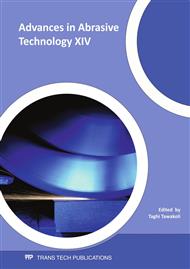p.457
p.464
p.470
p.476
p.482
p.489
p.495
p.502
p.508
Buffing Performance Analysis of Viscoelastic Polymer with Sensor-Less Polishing Pressure Control
Abstract:
Viscoelastic polymer with high scratch resistance has been developed for coating material of product. Due to some particular characteristics such as viscoelasticity, it is difficult to finish the polymer coated surface. In the present circumstances, its polishing process is carried out by the trained technician and depends on the skill like adjustment of the polishing pressure according to the situation. To realize automation of the polishing, high-precision and highly-responsive force control is required firstly. Typically force control is done with force sensor. However when external sensor is used, there are some problems such as high-cost, reduction of machine stiffness and thermal drift. The thermal drift which is caused by polishing heat prohibits accurate measuring of force. The purpose of this research is to develop the polishing pressure control method without any additional sensor. In addition, applying the control method to buffing machine, buffing performance of viscoelastic polymer is experimentally analyzed.
Info:
Periodical:
Pages:
482-488
Citation:
Online since:
August 2011
Authors:
Price:
Сopyright:
© 2011 Trans Tech Publications Ltd. All Rights Reserved
Share:
Citation:


